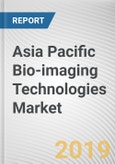The Asia Pacific bio-imaging technologies market is segmented based on the type of technology, applications and geography. The technology types are broadly classified into medical bio-imaging technologies and molecular bio-imaging technologies. These technologies are further segmented into segmented into optical Imaging, radiological imaging, magnetic resonance imaging, ultrasound imaging, nano bio-imaging and others. These bio-imaging technologies use advanced imaging techniques to improve the human health by providing targeted solutions in diagnosis, treatment and prevention of diseases. The Asia Pacific bio-imaging market is segmented into China, Japan, India, Australia and others. The emerging economies across the Asia Pacific such as China and India are the potential markets due to a high prevalence of diseases and improving healthcare systems. Moreover, the presence of a large population and growing medical tourism supplements the growth of the Asia pacific market. Recently, the Australian and Indian national imaging infrastructure organizations, entered into a partnership with Euro-bio imaging to promote the open access to imaging technologies.
KEY TAKE AWAYS
Widespread coverage of the Asia Pacific bio-imaging technologies market including drivers, restraints and opportunities would help professionals to better understand market behavior
The projections in the report are made by analyzing the current market trends and the market potential for the period of 2013-2020 in terms of value
A comprehensive analysis of technology types and geography segments highlights the identification of growth opportunities within the Asia Pacific bio-imaging technologies market
An analysis of strategies used by key leaders within the Asia Pacific bio-imaging technologies market would be informative for professionals in the corporate sector
Porters five forces framework examines the competitive structure of the Asia Pacific bio-imaging technologies market and would be helpful for strategic industry analysis
Identification of key investment pockets for bio-imaging technologies market would provide strategic assistance to the decision makers
Ease of doing business analysis should help in making strategic business decisions
ASIA PACIFIC BIO-IMAGING TECHNOLOGIES MARKET KEY SEGMENTS
The Asia Pacific bio-imaging technologies market is segmented into technology type and geography segments.
MARKET BY TECHNOLOGY TYPE
Medical Bio-imaging
Optical Imaging
Radiological imaging
Magnetic resonance imaging
Ultrasound imaging
Molecular Bio-imaging
Nano bio-imaging
Biomarkers
Molecular probes
Others
MARKET BY GEOGRAPHY
China
Japan
India
Australia
Others
Methodology
The analyst offers exhaustive research and analysis based on a wide variety of factual inputs, which largely include interviews with industry participants, reliable statistics, and regional intelligence. The in-house industry experts play an instrumental role in designing analytic tools and models, tailored to the requirements of a particular industry segment. The primary research efforts include reaching out participants through mail, tele-conversations, referrals, professional networks, and face-to-face interactions.
They are also in professional corporate relations with various companies that allow them greater flexibility for reaching out to industry participants and commentators for interviews and discussions.
They also refer to a broad array of industry sources for their secondary research, which typically include; however, not limited to:
- Company SEC filings, annual reports, company websites, broker & financial reports, and investor presentations for competitive scenario and shape of the industry
- Scientific and technical writings for product information and related preemptions
- Regional government and statistical databases for macro analysis
- Authentic news articles and other related releases for market evaluation
- Internal and external proprietary databases, key market indicators, and relevant press releases for market estimates and forecast
Furthermore, the accuracy of the data will be analyzed and validated by conducting additional primaries with various industry experts and KOLs. They also provide robust post-sales support to clients.

LOADING...








